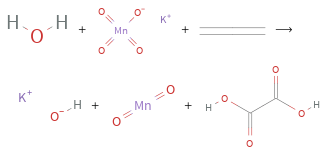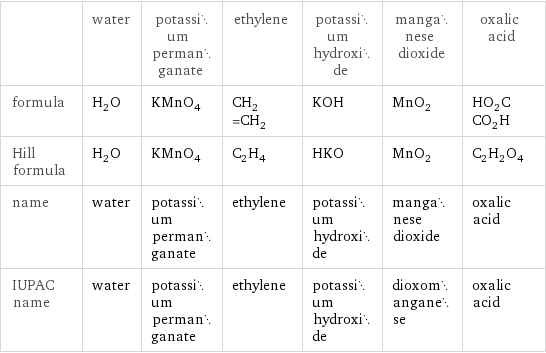Input interpretation

H_2O water + KMnO_4 potassium permanganate + CH_2=CH_2 ethylene ⟶ KOH potassium hydroxide + MnO_2 manganese dioxide + HO_2CCO_2H oxalic acid
Balanced equation

Balance the chemical equation algebraically: H_2O + KMnO_4 + CH_2=CH_2 ⟶ KOH + MnO_2 + HO_2CCO_2H Add stoichiometric coefficients, c_i, to the reactants and products: c_1 H_2O + c_2 KMnO_4 + c_3 CH_2=CH_2 ⟶ c_4 KOH + c_5 MnO_2 + c_6 HO_2CCO_2H Set the number of atoms in the reactants equal to the number of atoms in the products for H, O, K, Mn and C: H: | 2 c_1 + 4 c_3 = c_4 + 2 c_6 O: | c_1 + 4 c_2 = c_4 + 2 c_5 + 4 c_6 K: | c_2 = c_4 Mn: | c_2 = c_5 C: | 2 c_3 = 2 c_6 Since the coefficients are relative quantities and underdetermined, choose a coefficient to set arbitrarily. To keep the coefficients small, the arbitrary value is ordinarily one. For instance, set c_1 = 1 and solve the system of equations for the remaining coefficients: c_1 = 1 c_2 = 5 c_3 = 3/2 c_4 = 5 c_5 = 5 c_6 = 3/2 Multiply by the least common denominator, 2, to eliminate fractional coefficients: c_1 = 2 c_2 = 10 c_3 = 3 c_4 = 10 c_5 = 10 c_6 = 3 Substitute the coefficients into the chemical reaction to obtain the balanced equation: Answer: | | 2 H_2O + 10 KMnO_4 + 3 CH_2=CH_2 ⟶ 10 KOH + 10 MnO_2 + 3 HO_2CCO_2H
Structures

+ + ⟶ + +
Names

water + potassium permanganate + ethylene ⟶ potassium hydroxide + manganese dioxide + oxalic acid
Equilibrium constant
![Construct the equilibrium constant, K, expression for: H_2O + KMnO_4 + CH_2=CH_2 ⟶ KOH + MnO_2 + HO_2CCO_2H Plan: • Balance the chemical equation. • Determine the stoichiometric numbers. • Assemble the activity expression for each chemical species. • Use the activity expressions to build the equilibrium constant expression. Write the balanced chemical equation: 2 H_2O + 10 KMnO_4 + 3 CH_2=CH_2 ⟶ 10 KOH + 10 MnO_2 + 3 HO_2CCO_2H Assign stoichiometric numbers, ν_i, using the stoichiometric coefficients, c_i, from the balanced chemical equation in the following manner: ν_i = -c_i for reactants and ν_i = c_i for products: chemical species | c_i | ν_i H_2O | 2 | -2 KMnO_4 | 10 | -10 CH_2=CH_2 | 3 | -3 KOH | 10 | 10 MnO_2 | 10 | 10 HO_2CCO_2H | 3 | 3 Assemble the activity expressions accounting for the state of matter and ν_i: chemical species | c_i | ν_i | activity expression H_2O | 2 | -2 | ([H2O])^(-2) KMnO_4 | 10 | -10 | ([KMnO4])^(-10) CH_2=CH_2 | 3 | -3 | ([CH2=CH2])^(-3) KOH | 10 | 10 | ([KOH])^10 MnO_2 | 10 | 10 | ([MnO2])^10 HO_2CCO_2H | 3 | 3 | ([HO2CCO2H])^3 The equilibrium constant symbol in the concentration basis is: K_c Mulitply the activity expressions to arrive at the K_c expression: Answer: | | K_c = ([H2O])^(-2) ([KMnO4])^(-10) ([CH2=CH2])^(-3) ([KOH])^10 ([MnO2])^10 ([HO2CCO2H])^3 = (([KOH])^10 ([MnO2])^10 ([HO2CCO2H])^3)/(([H2O])^2 ([KMnO4])^10 ([CH2=CH2])^3)](../image_source/717127d44f939eaf06b7b3b025caf083.png)
Construct the equilibrium constant, K, expression for: H_2O + KMnO_4 + CH_2=CH_2 ⟶ KOH + MnO_2 + HO_2CCO_2H Plan: • Balance the chemical equation. • Determine the stoichiometric numbers. • Assemble the activity expression for each chemical species. • Use the activity expressions to build the equilibrium constant expression. Write the balanced chemical equation: 2 H_2O + 10 KMnO_4 + 3 CH_2=CH_2 ⟶ 10 KOH + 10 MnO_2 + 3 HO_2CCO_2H Assign stoichiometric numbers, ν_i, using the stoichiometric coefficients, c_i, from the balanced chemical equation in the following manner: ν_i = -c_i for reactants and ν_i = c_i for products: chemical species | c_i | ν_i H_2O | 2 | -2 KMnO_4 | 10 | -10 CH_2=CH_2 | 3 | -3 KOH | 10 | 10 MnO_2 | 10 | 10 HO_2CCO_2H | 3 | 3 Assemble the activity expressions accounting for the state of matter and ν_i: chemical species | c_i | ν_i | activity expression H_2O | 2 | -2 | ([H2O])^(-2) KMnO_4 | 10 | -10 | ([KMnO4])^(-10) CH_2=CH_2 | 3 | -3 | ([CH2=CH2])^(-3) KOH | 10 | 10 | ([KOH])^10 MnO_2 | 10 | 10 | ([MnO2])^10 HO_2CCO_2H | 3 | 3 | ([HO2CCO2H])^3 The equilibrium constant symbol in the concentration basis is: K_c Mulitply the activity expressions to arrive at the K_c expression: Answer: | | K_c = ([H2O])^(-2) ([KMnO4])^(-10) ([CH2=CH2])^(-3) ([KOH])^10 ([MnO2])^10 ([HO2CCO2H])^3 = (([KOH])^10 ([MnO2])^10 ([HO2CCO2H])^3)/(([H2O])^2 ([KMnO4])^10 ([CH2=CH2])^3)
Rate of reaction
![Construct the rate of reaction expression for: H_2O + KMnO_4 + CH_2=CH_2 ⟶ KOH + MnO_2 + HO_2CCO_2H Plan: • Balance the chemical equation. • Determine the stoichiometric numbers. • Assemble the rate term for each chemical species. • Write the rate of reaction expression. Write the balanced chemical equation: 2 H_2O + 10 KMnO_4 + 3 CH_2=CH_2 ⟶ 10 KOH + 10 MnO_2 + 3 HO_2CCO_2H Assign stoichiometric numbers, ν_i, using the stoichiometric coefficients, c_i, from the balanced chemical equation in the following manner: ν_i = -c_i for reactants and ν_i = c_i for products: chemical species | c_i | ν_i H_2O | 2 | -2 KMnO_4 | 10 | -10 CH_2=CH_2 | 3 | -3 KOH | 10 | 10 MnO_2 | 10 | 10 HO_2CCO_2H | 3 | 3 The rate term for each chemical species, B_i, is 1/ν_i(Δ[B_i])/(Δt) where [B_i] is the amount concentration and t is time: chemical species | c_i | ν_i | rate term H_2O | 2 | -2 | -1/2 (Δ[H2O])/(Δt) KMnO_4 | 10 | -10 | -1/10 (Δ[KMnO4])/(Δt) CH_2=CH_2 | 3 | -3 | -1/3 (Δ[CH2=CH2])/(Δt) KOH | 10 | 10 | 1/10 (Δ[KOH])/(Δt) MnO_2 | 10 | 10 | 1/10 (Δ[MnO2])/(Δt) HO_2CCO_2H | 3 | 3 | 1/3 (Δ[HO2CCO2H])/(Δt) (for infinitesimal rate of change, replace Δ with d) Set the rate terms equal to each other to arrive at the rate expression: Answer: | | rate = -1/2 (Δ[H2O])/(Δt) = -1/10 (Δ[KMnO4])/(Δt) = -1/3 (Δ[CH2=CH2])/(Δt) = 1/10 (Δ[KOH])/(Δt) = 1/10 (Δ[MnO2])/(Δt) = 1/3 (Δ[HO2CCO2H])/(Δt) (assuming constant volume and no accumulation of intermediates or side products)](../image_source/181b1916f94480c059dff4ba1d810298.png)
Construct the rate of reaction expression for: H_2O + KMnO_4 + CH_2=CH_2 ⟶ KOH + MnO_2 + HO_2CCO_2H Plan: • Balance the chemical equation. • Determine the stoichiometric numbers. • Assemble the rate term for each chemical species. • Write the rate of reaction expression. Write the balanced chemical equation: 2 H_2O + 10 KMnO_4 + 3 CH_2=CH_2 ⟶ 10 KOH + 10 MnO_2 + 3 HO_2CCO_2H Assign stoichiometric numbers, ν_i, using the stoichiometric coefficients, c_i, from the balanced chemical equation in the following manner: ν_i = -c_i for reactants and ν_i = c_i for products: chemical species | c_i | ν_i H_2O | 2 | -2 KMnO_4 | 10 | -10 CH_2=CH_2 | 3 | -3 KOH | 10 | 10 MnO_2 | 10 | 10 HO_2CCO_2H | 3 | 3 The rate term for each chemical species, B_i, is 1/ν_i(Δ[B_i])/(Δt) where [B_i] is the amount concentration and t is time: chemical species | c_i | ν_i | rate term H_2O | 2 | -2 | -1/2 (Δ[H2O])/(Δt) KMnO_4 | 10 | -10 | -1/10 (Δ[KMnO4])/(Δt) CH_2=CH_2 | 3 | -3 | -1/3 (Δ[CH2=CH2])/(Δt) KOH | 10 | 10 | 1/10 (Δ[KOH])/(Δt) MnO_2 | 10 | 10 | 1/10 (Δ[MnO2])/(Δt) HO_2CCO_2H | 3 | 3 | 1/3 (Δ[HO2CCO2H])/(Δt) (for infinitesimal rate of change, replace Δ with d) Set the rate terms equal to each other to arrive at the rate expression: Answer: | | rate = -1/2 (Δ[H2O])/(Δt) = -1/10 (Δ[KMnO4])/(Δt) = -1/3 (Δ[CH2=CH2])/(Δt) = 1/10 (Δ[KOH])/(Δt) = 1/10 (Δ[MnO2])/(Δt) = 1/3 (Δ[HO2CCO2H])/(Δt) (assuming constant volume and no accumulation of intermediates or side products)
Chemical names and formulas

| water | potassium permanganate | ethylene | potassium hydroxide | manganese dioxide | oxalic acid formula | H_2O | KMnO_4 | CH_2=CH_2 | KOH | MnO_2 | HO_2CCO_2H Hill formula | H_2O | KMnO_4 | C_2H_4 | HKO | MnO_2 | C_2H_2O_4 name | water | potassium permanganate | ethylene | potassium hydroxide | manganese dioxide | oxalic acid IUPAC name | water | potassium permanganate | ethylene | potassium hydroxide | dioxomanganese | oxalic acid
Substance properties

| water | potassium permanganate | ethylene | potassium hydroxide | manganese dioxide | oxalic acid molar mass | 18.015 g/mol | 158.03 g/mol | 28.054 g/mol | 56.105 g/mol | 86.936 g/mol | 90.03 g/mol phase | liquid (at STP) | solid (at STP) | gas (at STP) | solid (at STP) | solid (at STP) | solid (at STP) melting point | 0 °C | 240 °C | -169 °C | 406 °C | 535 °C | 189.5 °C boiling point | 99.9839 °C | | -104 °C | 1327 °C | | 365 °C density | 1 g/cm^3 | 1 g/cm^3 | 1.153 g/cm^3 (at 25 °C) | 2.044 g/cm^3 | 5.03 g/cm^3 | 1.948 g/cm^3 solubility in water | | | insoluble | soluble | insoluble | surface tension | 0.0728 N/m | | 0.0181 N/m | | | dynamic viscosity | 8.9×10^-4 Pa s (at 25 °C) | | 1.034×10^-5 Pa s (at 25 °C) | 0.001 Pa s (at 550 °C) | | odor | odorless | odorless | | | |
Units
